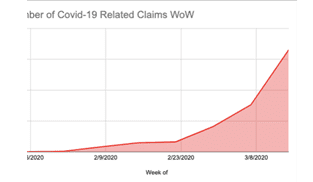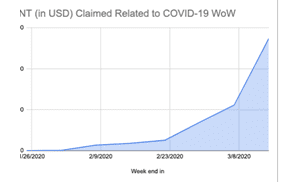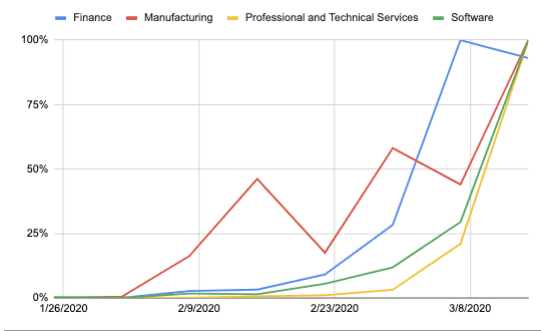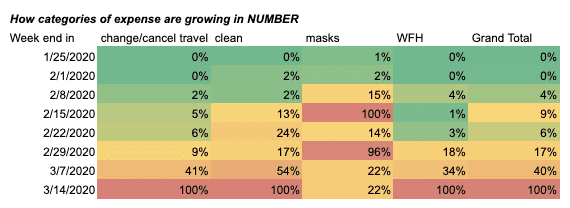As the situation surrounding COVID-19 has progressed, more travel restrictions and social distancing practices are being implemented every day. More and more companies are implementing work-from-home policies to adapt to the changing situation.
We’ve been tracking the data since the beginning of the crisis to help your company ensure employee health and safety and make essential decisions around expenses.
Here are a few of the most significant changes we’ve seen.
COVID-19 expenses haven’t shown any sign of slowing down
In our last blog, we noted that COVID-19 expenses skyrocketed, and we expected them to fall as trip cancelations began to taper off. However, these expenses have shown no sign of slowing down. COVID–19–related expenses have doubled from the week ending March 7 to the week ending March 14, with trip cancellation and work-from-home expenses being the primary causes.
Number of claims

Amount of claims

Submitted expenses vary by industry
Although changes to travel plans and cancelations still makeup over half of all COVID-19-related expense claims overall, the trends change when you look at specific industries.
In the finance and software industries, half of the expenses are related to travel cancelations, and the other half are work-from-home expenses.
In the consumer goods, manufacturing, and pharmaceutical industries, masks still make up 15 to 20% of expenses, but are otherwise in the low single digits in other industries.

The growth in expenses also varies by industry.

Work-from-home charges have increased dramatically; masks have fallen

Work from home expenses have grown the most, increasing 3.5x since last week. These charges are mainly related to “remote office setup” or “supplies for remote work,” and include accessories like printers, ink, headphones, and HDMI cables.
In our own workforce, we’ve noticed that everyone has a different set-up at home, ranging from at-home offices, to sitting with their spouse at the dining room table, or even sitting in bed with their laptops. It’s essential to employee productivity and ergonomics to help everyone make the best of whatever space they have.
Mask expenses have fallen – there was a peak in mid-February, then another dip, and a second peak at the end of February.

What does this data mean for my company’s expense policy?
We hope this data can help you consider the appropriate response to COVID-19 in your organization and how you can best support your employees. It’s clear from the above data that work-from-home expenses are increasingly common, and will likely continue to increase over the next few weeks as more companies continue to close their offices temporarily. We’ve also noticed that several companies have created specific expense types to track COVID-19 spending more closely. Others have created expense categories for their accounts payable departments to pay temporary workers more quickly in times of uncertainty.
If you’re unsure of what you should allow in your expense policy in response to the current climate, we’ve outlined some best practices on work-from-home expense policies from our peers and customers. In the meantime, we hope you and your company are taking the necessary precautions to ensure the health and safety of your employees during this unsettling time.










